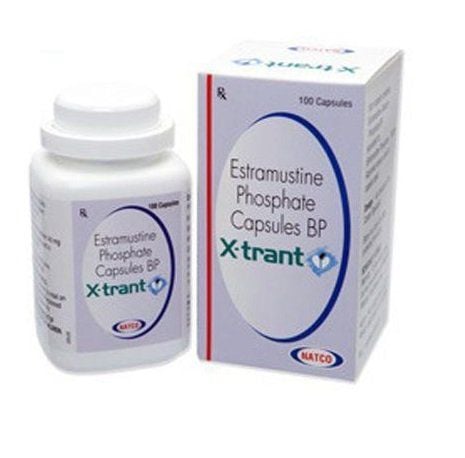This is an automatically translated article.
Enasidenib is indicated for the treatment of adult patients with recurrent or refractory acute myeloid leukemia (AML) with isocitrate dehydrogenase-2 (IDH2) mutations. Follow the article to better understand the use of Enasidenib.
1. What is Enasidenib?
Enasidenib is a type of targeted therapy called an isocitrate dehydrogenase-2 (IDH2) inhibitor. Enasidenib works by targeting and blocking the enzyme IDH 1. In some cancers, this receptor is overactive, causing cells to grow and divide too quickly. By inhibiting them, this drug can slow or stop tumor growth.
The oncologist will examine the patient's tumor for abnormalities. Patients eligible for this treatment are selected by testing for the presence of an IDH2 mutation in their blood or bone marrow. This small molecule acts as an allosteric inhibitor of the mutant IDH2 enzyme to suppress cell growth, and it has also been shown to block several other enzymes that play a role in abnormal cell differentiation.
2. What are the effects of Enasidenib?
Enasidenib is used to treat acute myeloid leukemia (AML) in adults with an IDH2 mutation.
Enasidenib may also be used for purposes not listed in the medication guide.
3. Drug interactions
Drug interactions can change how the drug works or increase the effect of side effects. Patients need to write a list of medications they are taking (including prescription drugs, non-prescription drugs and dietary supplements) for the doctor or pharmacist to see to prescribe appropriate.
4. How to take Enasidenib
Enasidenib comes in tablet form to be taken once a day. Because it is the best capsule form, patients should take it whole with water, do not open, break or chew.
Take your dose at the same time every day. If you miss a dose or vomit after taking it, take another dose as soon as possible the same day. Return to your usual dosing schedule the next day. Do not take 2 doses to make up for a missed dose.
In case the patient has difficulty swallowing their tablets, contact the treating doctor for assistance.
It is important for patients to make sure they are taking the correct amount of medication each time.
5. Storage and handling of Enasidenib
Store medication in its original, labeled packaging at room temperature and in a dry place
Keep container out of reach of children and pets.
6. Note to Patient Caregiver
Patient caregivers should consider wearing gloves or pouring medication directly from their container into a lid, small cup, or directly into the patient's hand to avoid touching the tablet.
Women who are pregnant or breast-feeding should not prepare doses because this medicine can be absorbed through the skin and lungs.
Always wash your hands before and after taking Estramustine.
Do not flush down the toilet or throw it in the trash.
7. Enasidenib side effects
Here are some common side effects of Estramustine use
Differentiation syndrome Enasidenib can cause very rapid maturation of myeloid cells, which can lead to serious side effects. This can happen at any time while taking this medicine. Contact your doctor immediately if any of the following signs appear: fever, trouble breathing, cough, chest pain, rapid weight gain (about 4.5 kg or more in 1 week), swelling in your hands , leg, neck, groin or armpit pain, or bone pain. This side effect can be treated with steroids.
Abnormal body electrolytes This medicine may affect some levels of electrolytes in the blood. Usually, it causes hyperbilirubinemia. Estramustine can also cause low calcium, low potassium, and low phosphorus. Elevated bilirubin can cause jaundice or yellowing of the skin and whites of the eyes. You should notify your doctor if you notice any of these symptoms. Electrolytes in the patient's body will be monitored with blood tests and treated as needed.
Nausea or vomiting Diarrhea Decreased appetite or change in appetite Nutrition is an important part of caring for a sick person. Cancer treatment can affect appetite, and in some cases, side effects of treatment with Estramustine can make it difficult to eat.
Try to eat five or six small meals or snacks throughout the day, instead of three large meals.
The sick person may experience a metallic taste or find that the food has no taste at all. Changes in taste, possible dislike of foods or drinks that were previously enjoyed before cancer treatment. These symptoms may persist for several months or longer after treatment ends.
Less common, but treatment with Estramustine also causes a number of other side effects, including:
Leukocytosis: This is a rapid increase in the number of white blood cells. Patients should be monitored for this condition with regular blood tests.
Tumor lysis syndrome: If there is a large amount of tumor cells in the body before treatment, the patient is at risk of tumor lysis syndrome. This happens when tumor cells die too quickly and their waste overwhelms the body. If you develop symptoms such as nausea, vomiting, diarrhea, or lethargy (drowsiness, lethargy), notify your doctor immediately. Tumor lysis syndrome can affect kidney function. The patient should drink plenty of water.
Fertility
Estramustine may affect fertility, leading to irregular menstrual cycles or sperm production or infertility.
For women: Women may experience menopausal effects including hot flashes and vaginal dryness. In addition, libido may decrease during treatment.
Exposure of the fetus to this drug can cause birth defects, so it is not recommended to become pregnant or father a child while taking this medicine. Effective birth control is necessary during treatment and for at least 2 months after treatment. Estramustine may affect blood levels of birth control hormones.
Patients taking Estramustine should not breast-feed during or for 2 months after the last dose.
Please dial HOTLINE for more information or register for an appointment HERE. Download MyVinmec app to make appointments faster and to manage your bookings easily.













